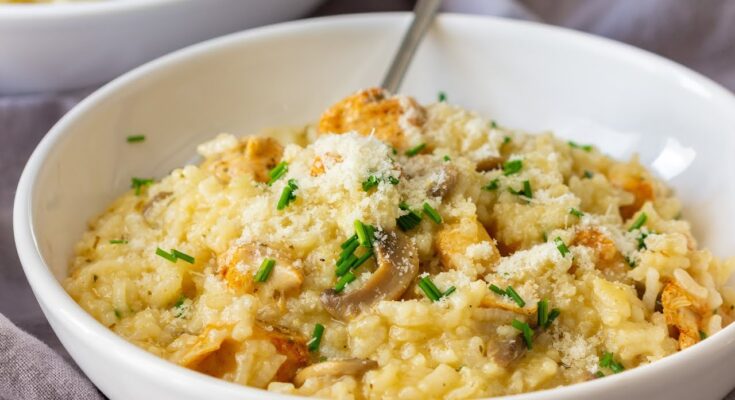Chicken Risotto Recipe: There’s something undeniably comforting about a warm bowl of chicken risotto. Creamy, rich, and packed with flavor, this Italian classic has become a go-to dish for cozy nights or elegant dinners alike. But many home cooks shy away from risotto because they think it’s complicated or too time-consuming. That ends today.
In this complete, human-friendly guide, you’ll learn everything about making the perfect chicken risotto, step-by-step — no fancy culinary school skills required. Whether you’re new to the kitchen or an experienced home chef looking to perfect your risotto game, this guide is for you.
Let’s get cooking!
What Is Chicken Risotto?
Chicken risotto is a creamy Italian rice dish where Arborio rice is slowly cooked with broth and flavored with sautéed chicken, onions, garlic, and Parmesan cheese. The result? A rich, velvety, savory meal that feels indulgent but is made from simple pantry staples.
Unlike regular rice, risotto isn’t just “boiled and done.” It’s all about slow cooking, stirring, and gradually adding liquid so the starches from the rice release and create that creamy texture. Add in perfectly cooked, juicy chicken and the right blend of herbs, and you’ve got a restaurant-quality dish right at home.
You don’t need to fly to Rome to enjoy this kind of comfort food — you can make it tonight in your kitchen.
Why You’ll Love This Chicken Risotto
- One-Pot Meal – Everything comes together in one pan, making cleanup a breeze.
- Hearty and Satisfying – The perfect balance of protein, carbs, and flavor.
- Comfort Food Classic – That creamy texture and warm flavors make it ideal for cozy nights.
- Impress Your Guests – Want to wow friends or family at a dinner party? This dish does the trick.
Whether it’s a weeknight or a special occasion, this dish delivers every single time.
Ingredients You’ll Need
Main Ingredients
Here’s your go-to grocery list for classic chicken risotto:
- 2 tablespoons olive oil
- 1 tablespoon unsalted butter
- 1 pound (450g) boneless, skinless chicken breast (or thighs), cubed
- 1 small onion, finely chopped
- 2 cloves garlic, minced
- 1 ½ cups Arborio rice
- ½ cup dry white wine (like Sauvignon Blanc)
- 4 to 5 cups low-sodium chicken broth (warm)
- ½ cup freshly grated Parmesan cheese
- Salt and freshly ground black pepper, to taste
- Fresh parsley, for garnish (optional)
Optional Add-Ins for Extra Flavor
- Mushrooms (button or cremini)
- Green peas
- Lemon zest
- Baby spinach
- A dash of cream for extra richness
- Chopped sun-dried tomatoes
Best Type of Rice for Risotto
Always use Arborio rice. It’s a short-grain Italian rice with a high starch content. This is what gives risotto its signature creaminess. You can also use Carnaroli or Vialone Nano if available, but never use long-grain rice like basmati or jasmine — it won’t work the same way.
Kitchen Tools You’ll Need
- Large sauté pan or deep skillet
- Wooden spoon or silicone spatula
- Ladle (for adding broth)
- Sharp knife and cutting board
- Measuring cups and spoons
- Medium saucepan (to warm broth)
Having everything ready makes this whole process smoother and more enjoyable.
Preparation Tips Before You Start Cooking
Before you light the stove, here are a few key steps to get you prepped:
- Warm your broth: This is critical. Cold broth will lower the temperature in your pan and stop the rice from cooking evenly.
- Cut your chicken into small cubes: This ensures quick, even cooking and better distribution throughout the dish.
- Grate your Parmesan fresh: Pre-shredded cheese often has anti-caking agents that mess with texture.
- Set up your station: Have all ingredients nearby and measured — risotto is all about timing and stirring.
Preparation is half the battle when it comes to making a great risotto!
Step-by-Step Chicken Risotto Recipe
Let’s break down this creamy goodness one delicious step at a time.
Step 1: Prepping the Ingredients
Chop the onion, mince the garlic, cube the chicken, and grate the Parmesan. Keep everything handy. Heat your chicken broth in a saucepan over low heat. Keeping it warm ensures that your risotto cooks evenly and absorbs the liquid properly.
Step 2: Cooking the Chicken
In your large skillet, heat 1 tablespoon of olive oil over medium-high heat. Add the cubed chicken, season with salt and pepper, and cook until golden brown on all sides, about 5-7 minutes. Once done, remove from the pan and set aside.
Don’t overcook it now — it’ll finish cooking when added back into the risotto later.
Step 3: Sautéing the Aromatics
In the same pan, add another tablespoon of olive oil and 1 tablespoon of butter. Toss in the chopped onion and sauté until translucent, about 3-4 minutes. Add the garlic and cook for another 30 seconds, just until fragrant.
This builds the flavor base that carries through the entire dish.
Step 4: Toasting the Rice
Add the Arborio rice straight into the pan with the onions and garlic. Stir constantly for 2-3 minutes until the grains are lightly toasted and start to look a bit translucent around the edges.
Toasting the rice is key to building flavor and helping the rice absorb liquid more effectively.
Step 5: Deglazing with Wine
Pour in the dry white wine, stirring as it sizzles. Let the alcohol cook off (about 1-2 minutes) — you’ll know it’s done when it doesn’t smell sharp anymore. The wine adds depth and a little acidity that balances the richness of the dish.
If you don’t want to use wine, substitute with an equal amount of broth and a splash of lemon juice.
Step 6: Gradually Adding the Broth
Start adding the warm chicken broth one ladle at a time, stirring constantly. Wait until each ladleful is almost fully absorbed before adding the next.
This slow method allows the rice to release its starch, creating that creamy, luscious risotto texture we all love.
Step 7: Stirring and Simmering
This is where patience pays off. Continue stirring and adding broth for about 18-20 minutes. You’ll see the rice start to plump and thicken beautifully.
At the 15-minute mark, stir in your cooked chicken so it finishes cooking with the risotto and soaks up the flavor.
Step 8: Finishing Touches
Once the rice is tender but still has a slight bite (al dente), and the risotto is creamy—not soupy—it’s time to finish it off.
Turn off the heat and stir in the Parmesan cheese. Adjust seasoning with salt and pepper. Add a knob of butter or splash of cream if you want it extra rich. Garnish with chopped parsley.
Serve immediately for the best texture.
Tips for Perfect Risotto Every Time
Making risotto isn’t rocket science, but it does require attention and a few solid techniques. Follow these pro tips to ensure your chicken risotto turns out creamy, flavorful, and totally irresistible:
- Use warm broth only – Adding cold broth cools down the pan and disrupts the cooking process. Keep the broth on a low simmer next to your risotto pan.
- Stir consistently—but not constantly – Stir often enough to prevent sticking and help the rice release starch, but you don’t need to stir every single second. Find that rhythm.
- Don’t rush – Risotto is a slow dance, not a sprint. Gradually adding broth and allowing each ladle to absorb creates the magic.
- Taste as you go – Start tasting around the 15-minute mark to check the rice’s texture. It should be soft with a slight al dente bite.
- Finish off the heat – Once cooked, remove from heat before adding Parmesan and butter. This prevents overcooking and keeps the texture perfect.
A little patience and love will make your risotto restaurant-worthy every single time.
Common Mistakes to Avoid
Avoid these rookie risotto errors, and you’ll be in creamy, savory heaven every time:
- Using the wrong rice – Only short-grain varieties like Arborio or Carnaroli will yield that creamy texture. Long-grain rice will just get mushy.
- Skipping the toasting step – Toasting the rice adds depth of flavor and helps it absorb broth better.
- Dumping in all the broth at once – Big mistake! Gradual addition is key to getting that smooth, luxurious consistency.
- Neglecting seasoning – Salt and pepper might seem basic, but they make or break the final flavor.
- Overcooking the rice – Mushy risotto is a no-go. Keep checking for that slight bite in the center of the rice grains.
Avoid these missteps and your risotto will earn standing ovations every time.
Serving Suggestions
Chicken risotto is a complete dish on its own, but a few smart pairings can turn it into a full Italian-inspired meal:
- Fresh Side Salad – A crisp green salad with lemon vinaigrette cuts through the richness.
- Garlic Bread or Crusty Baguette – Perfect for soaking up every last bit of risotto on the plate.
- Roasted Vegetables – Asparagus, zucchini, or bell peppers balance out the dish.
- White Wine Pairing – Pair with a chilled glass of Chardonnay or Pinot Grigio for a classy touch.
Keep it simple, and let the risotto be the star of the show.
Variations of Chicken Risotto
Once you master the base recipe, the fun really begins. Here are a few tasty ways to remix your risotto:
Creamy Mushroom Chicken Risotto
Add sliced cremini or shiitake mushrooms with the onions for an earthy flavor boost. Use a touch of cream at the end to heighten the richness.
Lemon Herb Chicken Risotto
Add lemon zest and a splash of juice during the final step. Stir in fresh herbs like basil or thyme for a bright, fresh finish.
Spicy Cajun Chicken Risotto
Toss your chicken in Cajun seasoning before cooking. Add some chopped bell peppers or even jalapeños for a spicy Southern twist.
These variations keep your meals exciting without having to learn a whole new dish from scratch.
How to Store and Reheat Leftovers
Got leftovers? Good news — risotto stores surprisingly well if you handle it right.
- To Store: Transfer cooled risotto into an airtight container. Keep it in the refrigerator for up to 3 days.
- To Reheat: Add a splash of broth or water before reheating in a pan over medium-low heat. Stir often to bring back the creamy texture.
- Microwave Option: Place in a microwave-safe bowl, add a bit of broth or water, cover loosely, and heat in 30-second intervals, stirring between.
Avoid freezing risotto — it tends to get grainy and lose its creamy texture once thawed.
Make-Ahead Tips
While risotto is best served fresh, you can do some prep ahead of time:
- Pre-cook the chicken – Store it in the fridge and add during the final stages of risotto cooking.
- Chop all aromatics and veggies – Keep them ready in containers or bags.
- Warm the broth in advance – Just reheat when you’re ready to cook.
By prepping ahead, you’ll be able to whip up this dish in under 30 minutes when hunger strikes.
Nutritional Information (Approximate)
Here’s a ballpark idea of what you’re eating per serving (based on 4 servings total):
| Nutrient | Amount per Serving |
|---|---|
| Calories | 520–600 kcal |
| Protein | 35g |
| Carbohydrates | 45g |
| Fat | 22g |
| Saturated Fat | 7g |
| Fiber | 2g |
| Sodium | 500mg |
This can vary based on add-ins, broth, and cheese quantities, so use a nutrition tracker for precision.
FAQs about Chicken Risotto Recipe
1. Can I make chicken risotto without wine?
Yes! Substitute the wine with more broth and a squeeze of lemon juice to add acidity.
2. What can I use instead of Arborio rice?
Carnaroli or Vialone Nano are great substitutes. Regular long-grain rice won’t work well because it lacks the starch needed for creaminess.
3. Can I use pre-cooked chicken?
Absolutely. Just shred it and add it during the last 5 minutes of cooking to warm through.
4. How do I know when the risotto is done?
The grains should be tender with a slight bite, and the mixture should be creamy—not dry or soupy.
5. Can I make this dish dairy-free?
Yes. Use olive oil instead of butter, skip the cheese, or replace it with nutritional yeast or dairy-free Parmesan alternatives.
Final Thoughts
Making a creamy, flavorful chicken risotto isn’t just about following steps — it’s about bringing a bit of love and attention to every stage. From toasting the rice to slowly stirring in broth, this dish rewards patience with a mouthwatering payoff.
Whether you’re making it for a cozy dinner at home, impressing guests, or just craving some next-level comfort food, this chicken risotto recipe will always deliver. And the best part? Once you’ve nailed the basics, the variations are endless.
Happy cooking — and more importantly, happy eating!



